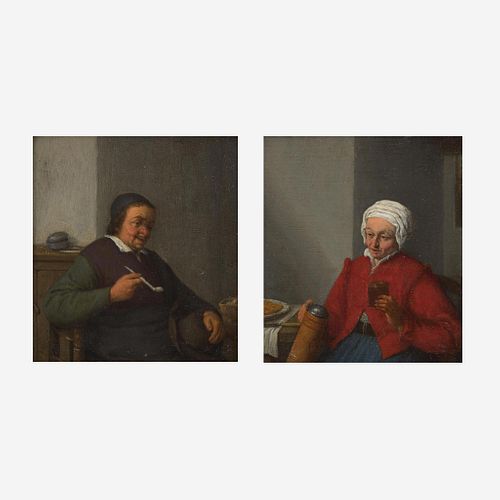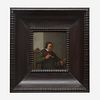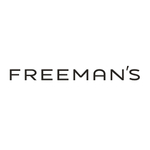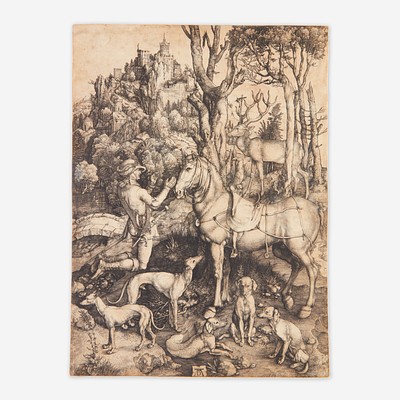Adriaen Jansz van Ostade (Dutch, 1610?1685) Man Smoking in an Interior; together with Woman Holding a Jug and a Cup: A Pair of Half-Length Portraits
About Seller
2400 Market St
Philadelphia, PA 19147
United States
Established in 1805, Freeman’s Auction House holds tradition close, with a progressive mind-set towards marketing and promotion, along with access to a team of top experts in the auction business. And now with offices in New England, the Southeast, and on the West Coast, it has never been easier to ...Read more
Two ways to bid:
- Leave a max absentee bid and the platform will bid on your behalf up to your maximum bid during the live auction.
- Bid live during the auction and your bids will be submitted real-time to the auctioneer.
Bid Increments
| Price | Bid Increment |
|---|---|
| $0 | $25 |
| $500 | $50 |
| $1,000 | $100 |
| $2,000 | $200 |
| $3,000 | $250 |
| $5,000 | $500 |
| $10,000 | $1,000 |
| $20,000 | $2,000 |
| $30,000 | $2,500 |
| $50,000 | $5,000 |
| $100,000 | $10,000 |
About Auction
Feb 22, 2022
Auguste Rodin’s Mère et Fille Mourante, a moving mother-and-child sculpture, leads Freeman’s February 22 European Art and Old Masters auction; the work was commissioned by Mrs. Thomas Merrill in 1908 and has remained in the family for over a century. Curated by David Weiss, Head of Sale. Freeman's info@freemansauction.com
- Lot Description
Adriaen Jansz van Ostade (Dutch, 1610?1685) Man Smoking in an Interior; together with Woman Holding a Jug and a Cup: A Pair of Half-Length Portraits
Each with the Artist's monogram 'AvO' (the man: center left, on the wooden cabinet; the woman: bottom left, on the edge of the table), pair oils on (oak) panel
First: 6 3/8 x 5 5/8 in. (16.2 x 14.3cm)
Second: 6 3/8 x 5 1/2 in. (16.2 x 14cm)
(2)
Qty: (2)Provenance
Collection of M. Flersheim, Paris, 1906.
Private Collection, Pennsylvania.
Footnote:Exhibited
Frederik Muller and Co., Amsterdam, the Netherlands, 1906, no. 99 (the pair).
Literature
Cornelis Hofstede de Groot, A Catalogue Raisonn? of the Works of the Most Eminent Dutch Painters of the Seventeenth Century, Vol. III, Macmillan, London, 1910, pp. 193-194, no. 177 (for the man, listed as Smoker) and p. 208, no. 222 (for the woman, listed as Drinker)
Note
Adriaen van Ostade was born in Haarlem in December 1610 and spent all of his life in his native town, dying there on May 2, 1685. A student of Frans Hals along with Adriaen Brouwer, van Ostade seemed to have had more affinity with his colleague than with his master, as both liked to depict the daily life of the lower class: men and women shown dancing, drinking, eating or playing music. As in the present paintings, van Ostade also painted single figures, known as tronies. In such paintings, the figure ? frequently smoking or drinking - occupies most of the picture plane, offering the viewer greater personal engagement with the subject.
The present pair of panels shows van Ostade's predilection for common subjects and his set distance from the art of Hals, through the use of carefully blended colors. They also differ from van Ostade?s earlier work, usually more violent, sometimes headed toward caricature, and generally proned to a monochromatic palette. Each panel here is constructed around a combination of two bold, pure colors: green and purple for the man, red and blue for the woman, while the rest of the composition is limited to a few, neutral tints of brown, light grey, and soft cream. Unlike many of his contemporaries who depicted smoking men and drinking women to suggest a moral flaw, and denounce such leisure activities, van Ostade reveals an innocuous couple, caught in harmless daily-life activities. The figures appear less coarse, friendlier than the tavern drinkers van Ostade usually depicted. Their face is incredibly detailed, making them recognizable among many. Such precision also conveys an overall sense of individuality and dignity. The lighting is very subtle, the two figures are poised, tranquil, which reflects van Ostade's own views on domesticity - a blessed sanctuary where people live in harmony with each other.
The sale of this recently rediscovered pair of van Ostade portraits is noteworthy, as few "official pairs" have subsisted over the years. This one specifically had disappeared after it was exhibited in Frederick Muller?s Rembrandt Exhibition in Amsterdam in 1906. Freshly cleaned, the panels each reveal an outstanding harmony of colors, seen as the hallmark of van Ostade's oeuvre. The pair is set to be included in Dr. Hiltraud Doll?s forthcoming monograph on the artist.
- Shipping Info
-
No lot may be removed from Freeman’s premises until the buyer has paid in full the purchase price therefor including Buyer’s Premium or has satisfied such terms that Freeman’s, in its sole discretion, shall require. Subject to the foregoing, all Property shall be paid for and removed by the buyer at his/ her expense within ten (10) days of sale and, if not so removed, may be sold by Freeman’s, or sent by Freeman’s to a third-party storage facility, at the sole risk and charge of the buyer(s), and Freeman’s may prohibit the buyer from participating, directly or indirectly, as a bidder or buyer in any future sale or sales. In addition to other remedies available to Freeman’s by law, Freeman’s reserves the right to impose a late charge of 1.5% per month of the total purchase price on any balance remaining ten (10) days after the day of sale. If Property is not removed by the buyer within ten (10) days, a handling charge of 2% of the total purchase price per month from the tenth day after the sale until removal by the buyer shall be payable to Freeman’s by the buyer. Freeman’s will not be responsible for any loss, damage, theft, or otherwise responsible for any goods left in Freeman’s possession after ten (10) days. If the foregoing conditions or any applicable provisions of law are not complied with, in addition to other remedies available to Freeman’s and the Consignor (including without limitation the right to hold the buyer(s) liable for the bid price) Freeman’s, at its option, may either cancel the sale, retaining as liquidated damages all payments made by the buyer(s), or resell the property. In such event, the buyer(s) shall remain liable for any deficiency in the original purchase price and will also be responsible for all costs, including warehousing, the expense of the ultimate sale, and Freeman’s commission at its regular rates together with all related and incidental charges, including legal fees. Payment is a precondition to removal. Payment shall be by cash, certified check or similar bank draft, or any other method approved by Freeman’s. Checks will not be deemed to constitute payment until cleared. Any exceptions must be made upon Freeman’s written approval of credit prior to sale. In addition, a defaulting buyer will be deemed to have granted and assigned to Freeman’s, a continuing security interest of first priority in any property or money of, or owing to such buyer in Freeman’ possession, and Freeman’s may retain and apply such property or money as collateral security for the obligations due to Freeman’s. Freeman’s shall have all of the rights accorded a secured party under the Pennsylvania Uniform Commercial Code.
-
- Buyer's Premium



 EUR
EUR CAD
CAD AUD
AUD GBP
GBP MXN
MXN HKD
HKD CNY
CNY MYR
MYR SEK
SEK SGD
SGD CHF
CHF THB
THB













